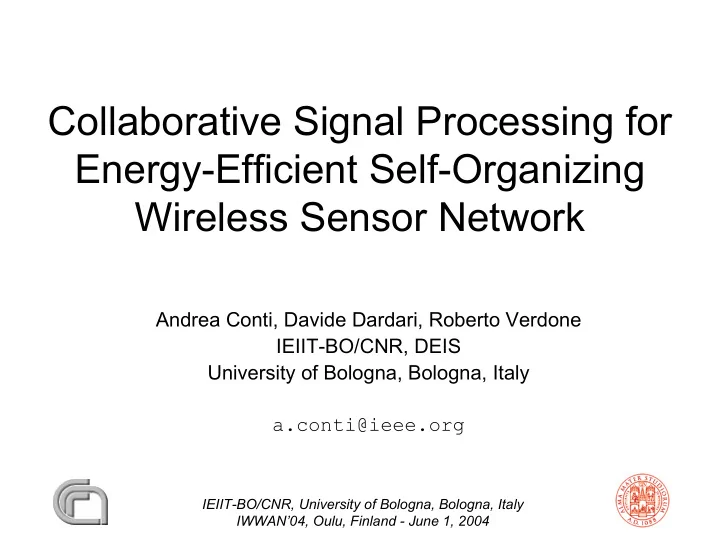

Collaborative Signal Processing for Energy-Efficient Self-Organizing Wireless Sensor Network Andrea Conti, Davide Dardari, Roberto Verdone IEIIT-BO/CNR, DEIS University of Bologna, Bologna, Italy a.conti@ieee.org IEIIT-BO/CNR, University of Bologna, Bologna, Italy IWWAN’04, Oulu, Finland - June 1, 2004
Introduction We analyze the performance of a dense energy-efficient � Wireless Sensor Network for distributed collaborative environment monitoring The target multi-dim process is estimate from samples � captured by nodes (sensor+wireless transceiver) randomly uniformly distributed We evaluate the impact of � Collaborative Signal Processing on both – estimation error – lifetime IEIIT-BO/CNR, University of Bologna, Bologna, Italy IWWAN’04, Oulu, Finland - June 1, 2004
Motivations of the work � Many applications require sensing from random node’s position � Many papers in the literature are based on simulations or consider deterministic channels � analytical framework for WSN design in realistic wireless medium � WSN design aspects: - Channel model � path-loss + shadowing - Connectivity Low-cost device � proper - Energy consumption balance between - Information routing communication capabilities - Process estimation quality and signal processing - Node’s density - Localization (centralized or distributed) - MAC protocol - System and process parameters IEIIT-BO/CNR, University of Bologna, Bologna, Italy IWWAN’04, Oulu, Finland - June 1, 2004
Self-organized WSN Supervisor more capable (in processing and transmission) than other nodes that are typically in sleep mode and periodically commute in rx mode SV triggers ↓ triggered nodes organize thamselves into cluster with random selection of the node Cluster Head ↓ round each node sent its sample to its CH CSP No CSP each CH sends a properly each CH sends the aggregate processed information to the information of its cluster to the SV that estimate the process SV that estimate the process SV estimates the process IEIIT-BO/CNR, University of Bologna, Bologna, Italy IWWAN’04, Oulu, Finland - June 1, 2004
LEACH-based alg. More information to be transmitted from CH (greater energy consumption) Random election of CH at each trigger with prob. x IEIIT-BO/CNR, University of Bologna, Bologna, Italy IWWAN’04, Oulu, Finland - June 1, 2004
Statistical analysis of connectivity shadowing ~N(0, σ 2 ) Propagation-loss (dB) Readapting theory in [12][13] to WSN: …infinite plane of Poisson distributed nodes with density ρ � The number of nodes triggered by SV is Poisson distr. with mean � Self-election of CH N ch =x N t ρ ch =x ρ � Broadcasting to notify CH’s election P t = α P su IEIIT-BO/CNR, University of Bologna, Bologna, Italy IWWAN’04, Oulu, Finland - June 1, 2004
� Cluster selection (each nonCH node associates itself to the strongest rx CH) � Mean cluster dimension, n p Poisson distributed with mean � Probability to have triggered but isolated nodes IEIIT-BO/CNR, University of Bologna, Bologna, Italy IWWAN’04, Oulu, Finland - June 1, 2004
� Energy spent by the CH to tx information - no CSP � (np+1) E H /T - CSP � m E H /T + energy spent for signal processing E csp � Energy spent by a nonCH E H α /T Energy budget IEIIT-BO/CNR, University of Bologna, Bologna, Italy IWWAN’04, Oulu, Finland - June 1, 2004
Target Process Estimation Sample space limited by SV tx range x( s ) has finite energy with bandwidth per dimension B and Sequence of spatial samples is an Homogeneous Poisson point process With linear interpolation of sampled version of the target process we estimate IEIIT-BO/CNR, University of Bologna, Bologna, Italy IWWAN’04, Oulu, Finland - June 1, 2004
Normalized Estimation Error Without CSP � ς =1, oversampling factor With CSP � the CH estimate the process in its cluster and re-sample @ Nyquist frequency to tx to the SV only M samples ς =Nch IEIIT-BO/CNR, University of Bologna, Bologna, Italy IWWAN’04, Oulu, Finland - June 1, 2004
Energy Budget Mean energy/round spent by a node. Without CSP With CSP WSN lifetime IEIIT-BO/CNR, University of Bologna, Bologna, Italy IWWAN’04, Oulu, Finland - June 1, 2004
By playing with the parameters and CSP different trade-offs between WSN lifetime and process estimation quality are possible, e.g., IEIIT-BO/CNR, University of Bologna, Bologna, Italy IWWAN’04, Oulu, Finland - June 1, 2004
IEIIT-BO/CNR, University of Bologna, Bologna, Italy IWWAN’04, Oulu, Finland - June 1, 2004
IEIIT-BO/CNR, University of Bologna, Bologna, Italy IWWAN’04, Oulu, Finland - June 1, 2004
IEIIT-BO/CNR, University of Bologna, Bologna, Italy IWWAN’04, Oulu, Finland - June 1, 2004
IEIIT-BO/CNR, University of Bologna, Bologna, Italy IWWAN’04, Oulu, Finland - June 1, 2004
IEIIT-BO/CNR, University of Bologna, Bologna, Italy IWWAN’04, Oulu, Finland - June 1, 2004
Conclusions We addressed interdependent aspects for WSN design by developing an analytical framework The trade-off between process estimation quality and life-time can evaluated The adoption of CSP can strongly improve the network life-time IEIIT-BO/CNR, University of Bologna, Bologna, Italy IWWAN’04, Oulu, Finland - June 1, 2004
Recommend
More recommend